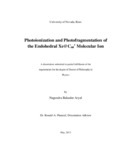Please use this identifier to cite or link to this item:
http://archive.nnl.gov.np:8080/handle/123456789/299| Title: | Photoionization and photofragmentation of the endohedral Xe@C60+ molecular ion |
| Authors: | Aryal, Nagendra Bahadur |
| Keywords: | Noble-gas endohedral Xe@C60+ molecular ion |
| Issue Date: | 25-Feb-2018 |
| Abstract: | An experimental study of photoionization and fragmentation of the Xe@C60+ endohedral molecular ion is presented in the photon energy range of the well-known Xe 4d giant resonance, and evidence of redistribution of the Xe 4d oscillator strength in photon energy due to multipath interference is reported. Experiments were conducted at undulator beamline 10.0.1 of the Advanced Light Source (ALS) using the merged-beams technique. Prior to these measurements, macroscopic samples containing endohedral Xe@C60 were prepared using a setup developed at the ALS. Endohedral Xe@C60 yields as high as 2.5x10-4 were synthesized and a pure Xe@C60+ ion beam current of up to 5.5 pA was obtained for the merged-beams experiments. Cross sections were measured in the photon energy range 60 - 150 eV in 0.5 eV steps for single, double, and triple photoionization of endohedral Xe@C60+ accompanied by the loss of n pairs of carbon atoms yielding Xe@C60-2n2+ (n = 0, 1), Xe@C60-2n3+ (n = 0, 1, 2, 3), and Xe@C584+ photo-ion products. Reference absolute cross-section measurements were made for empty C60+ for the corresponding reaction channels. The spectroscopic measurements with Xe@C60+ were placed onto an absolute scale by normalization to the reference cross sections for C60+ in ranges of photon energies where the Xe 4d contributions were negligible. Results for single photoionization and fragmentation of Xe@C60+ show no evidence of the presence of the caged Xe atom. The measurements of double and triple photoionization with fragmentation of Xe@C60+ exhibit prominent signatures of the Xe 4d resonance and together account for 6.6 ± 1.5 of the total Xe 4d oscillator strength of 10. Compared to that for a free Xe atom, the Xe oscillator strength in Xe@C60+ is redistributed in photon energy due to multipath interference of outgoing Xe 4d photoelectron waves that may be transmitted or reflected by the spherical C60+ molecular cage, yielding so-called confinement resonances. The experimental data are compared with numerous theoretical predictions for this novel single-molecule photoelectron interferometer system. The comparison indicates that the interference structure is sensitive to the geometry of the molecular cage. |
| Description: | A dissertation submitted in partial fulfillment of the requirements for the degree of Doctor of Philosophy in Physics, University of Nevada Reno, 2013. |
| URI: | http://103.69.125.248:8080/xmlui/handle/123456789/299 |
| Appears in Collections: | 500 Natural sciences and mathematics |
Files in This Item:
| File | Description | Size | Format | |
|---|---|---|---|---|
| My Dissertation nagendra aryal.pdf | 3.49 MB | Adobe PDF |  View/Open |
Items in DSpace are protected by copyright, with all rights reserved, unless otherwise indicated.